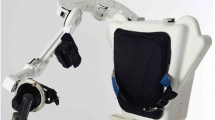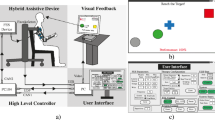Abstract
Upper-limb orthotic systems have been designed for restoring the upperlimb functions of individuals with disabilities resulting from spinal cord injury (SCI), stroke and muscular dystrophy. These systems employ either functional electrical stimulation or external power. It is proposed that, instead of time-consuming and complicated monitoring using sensors and motion analysis, a software simulator with both angular displacement and acceleration parameters can facilitate the design of a control strategy for an orthosis. Reaching movements of three cervical SCI subjects are used to verify the simulator. A motion analysis system is used to measure the range of motion and joint angles during hand reaching. Results indicate that quaternion and spline curve techniques are suitable for interpolation of the hand reaching movements. The information needed for good simulation only compress the shoulder and elbow joint angles in a few key postures. Stimulated acceleration signals on the upper-arm segment have a high correlation coefficient (>0.9) and a small root mean squared error (<0.11 g) with a real bi-axial accelerometer.
Similar content being viewed by others
Abbreviations
- \(\bar p(t)\) :
-
is vector of position of sensor in 3D space at timet
- \(\bar s_{upperarm} (t)\) :
-
is unit vector of axis along upper arm segment
- \(\bar s_{forearm} (t)\) :
-
is unit vector of axis along forearm segment
- d1 sensor :
-
is distance of sensor from shoulder joint towards distal end
- d2 sensor :
-
is distance of sensor from elbow joint towards distal end
- [R] resultant :
-
is 3×3 rotation matrix that was calculated from laboratory co-ordinate system to local co-ordinate system of sensor
- [R] sensor :
-
is sensor orientation with respect to attached segment
- [R] forearm :
-
is forearm orientation with respect to upper arm segment
- [R] upperarm :
-
is upper arm orientation with respect to laboratory co-ordinate system
References
Bedbrook, G. M. (1985): ‘A balanced viewpoint in the early management of patients with spinal injuries who have neurological damage’,Paraplegia,23, pp. 8–15
Buckley, M. A., andJohnson, G. R. (1997): ‘Computer simulation of the dynamics of a human arm and orthosis linkage mechanism’,Proc. Inst. Mech Eng.,211(5), pp. 349–357
Cameron, T., Mcdonald, K., Anderson, L., andProchazka, A. (1991): ‘The effect of wrist angle on electrically evoked hand opening in patients with spastic hemiplegia’,IEEE Trans. Rehab. Eng.,7, pp. 109–111
Crago, P. E., Lan, N., Veltink, P. H., Abbas, J. J., andKantor, C. (1996): ‘New control strategies for neuroprosthetic systems’,J. Rehab. Res. Dev.,33, pp. 158–172
Devivo, M. J., Stover, S. L., andBlack K. J. (1992): ‘Prognostic factors for 12-year survival after spinal cord injury’,Arch. Phys. Med. Rehab.,73, pp. 156–162
Foley, J. D., Van Dam, A. et al. (1990): ‘Computer graphics—principles and practice’ (Addison-Wesley Publishing Company), 2nd edn
Hunter, J. M., Mackin, E. J., andCllahan, A. D. (1995): ‘Rehabilitation of the hand: surgery and therapy’ (Mosby), 4th edn
Lawlor, B. D. (1998): ‘A new dynamic triceps-driven orthosis (DTDO): achieving elbow flexion in patients with C5 deficits’,Arch. Phys. Med. Rehab.,79, pp. 1309–1311
Lemay, M. A., Hogan, N., andArian Van Dorsten, J. W. (1998): ‘Issues in impedance selection and input devices for multijoint powered orthotics’,IEEE Trans. Rehab. Eng.,6, pp. 102–105
Nigg, B. M., andHerzog, W. (1994): ‘Biomechanics’ (Wiley) p. 355
Nigro, G., Comi, L. I., Limongelli, F. M., Giugliano, M. A., Politano, L., Petretta, V., Passamano, L., andStefanelli, S. (1983): ‘Prospective study of X-linked progressive muscular dystrophy in Campania’,Muscle Nerve,6, pp. 253–262
Romily, D. P., Anglin, C., Gosine, R. G., Hershler, C., andRaschke, S. U. (1994): ‘A functional task analysis and motion simulation for the development of a powered upper-limb orthosis’,IEEE Trans. Rehab. Eng.,2, pp. 119–129
Sandin, K. J., andMason, K. D. (1996): ‘Manual of stroke rehabilitation’ (Butterworth-Heinemann)
Stover, S. L., Devivo, M. J., andGo, B. K. (1999): ‘History, implementation, and current status of the National Spinal Cord Injury Database’,Arch. Phys. Med. Rehab.,80, pp. 1365–1371
Triolo, R., Nathan, R., Handa, Y. et al. (1996): ‘Challenges to clinical deployment of upper limb neuroprostheses’,J. Rehab. Res. Dev.,33, pp. 111–122
Tong, K. Y., andGranat, M. H. (1999): ‘The use of neural networks and virtual sensors for the control of FES assisted walking’,Med. Biol. Eng. Comput.,37, pp. 35–41
Williams, W. R., Thompson, M. W., andMorton, N. E. (1983): ‘Complex segregation analysis and computer-assisted genetic risk assessment for Duchenne muscular dystrophy’,Am. J. Med. Genet.,14, pp. 315–333
Yarkony, G. M., Roth, E. J., Cybulski, G., andJaeger, R. J. (1992): ‘Neuromuscular stimulation in spinal cord injury I: Restoration of functional movement of the extremities’,Arch. Phys. Med. Rehabil.,73, pp. 78–86
van der Helm, F. C. T. (1997): ‘A standardized protocol for motion recordings of the shoulder’. Proc. 1st Conf. Int. Shoulder Group, Shaker Publishers, Maastricht, pp. 7–12
Wu, G., andLadin, Z. (1996): ‘The study of kinematic transients in locomotion using the integrated kinematic sensor’,IEEE Trans. Rehab. Eng.,4, pp. 193–200
Author information
Authors and Affiliations
Corresponding author
Rights and permissions
About this article
Cite this article
Tong, K.Y., Mak, A.F.T. Development of computer-based environment for simulating the voluntary upper-limb movements of persons with disability. Med. Biol. Eng. Comput. 39, 414–421 (2001). https://doi.org/10.1007/BF02345362
Received:
Accepted:
Issue Date:
DOI: https://doi.org/10.1007/BF02345362




